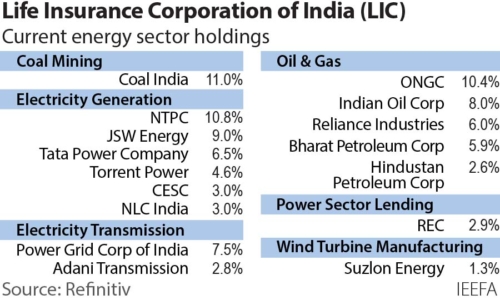IEEFA: Life Insurance Corporation of India’s ESG push

The country’s largest institutional investor, Life Insurance Corporation of India (LIC), is slated to hit the capital markets with an initial public offering (IPO) as early as the end of the current fiscal year, in line with the Government of India’s divestment plans.
With nearly US$500bn in assets and a valuation estimated up to US$203bn, the IPO is touted to be India’s largest till date and is bound to elicit interest from all quarters, domestically and globally.

The government wants an active participation from foreign institutional investors too and is mulling changes in the foreign direct investment (FDI) policy. Equity investment by foreign investors is allowed for most Indian insurers, but not in LIC, which is a special entity created by an Act of Parliament.
In parallel, the finance ministry is reportedly also working to complete an environment, social and governance (ESG) rating for the insurance behemoth before its mega IPO hits the market, to tap into the large and growing global pool of ESG-aligned assets.
Investors are aligning with ESG
The number of investors aligning their practices with ESG has exploded in the past two years.
These signatories commit to integrating ESG factors
Bloomberg expects ESG assets to hit US$53 trillion by 2025, a third of global assets under management. Further, the United Nations-supported Principles for Responsible Investment (PRI), the world’s leading proponent of responsible investment, has more than 3,500 signatories, among them the world’s biggest institutional investors representing US$121tn in assets under management. These signatories commit to integrating ESG factors into investment decision making.
Most of the largest companies in the world are already reporting their ESG profile in line with globally recognised frameworks or standards.
Indian companies are lagging
Indian companies have been slow to catch up, lacking both regulation and a push from domestic institutional investors. The regulatory environment is transforming as the new business responsibility and sustainability reporting (BRSR) standards become mandatory for Indian companies, requiring listed companies to disclose their ESG footprint.
With LIC going for an ESG rating, it is clear the government wants the country’s biggest asset manager to be better placed to anticipate future risks and opportunities in its operations and investment practices.
LIC must have a credible ESG strategy
To get a favourable rating and get on the radar of global institutional investors, LIC must have a credible ESG strategy. This will entail improving and working upon its most material ESG risks and capitalizing on the most pertinent ESG opportunities. A high ESG rating may bring in long term patient investors and boost the company’s valuation but it will also invite pressure from these investors to improve the ESG profile. This implies LIC will have to put current and future investments under the ESG lens.
As the insurer holds more than 3.5% of the listed equity universe in India, this development is bound to create a buzz in corporate boardrooms around the country and lead to companies rethinking their ESG strategies in turn, to avoid scrutiny and pressure from one of their biggest investors. LIC holds more than 1% stake in 281 companies in India, covering the energy, banking, IT and commodities sectors among several others.
ESG is an existential question for energy companies
All companies in which LIC holds a stake will be scrutinised, especially energy companies given their weak environmental profile. The pressure to address ESG issues is increasingly an existential question for energy companies as governments worldwide set net-zero targets — and as the current media and wider public attention on climate change force companies to decarbonise.
Current media and wider public attention on climate change is forcing companies to decarbonise
Crisil last year launched a report on ESG scores of the top 225 Indian companies. The report shows a stark difference in ratings between sectors. The IT and financial sectors have the highest scores, while oil and gas and thermal power lie towards the lower end. Renewable energy owing to its environmental profile also ranks high.
LIC still investing in oil and gas
LIC’s exposure to oil and gas and thermal power companies can potentially tarnish its overall ESG profile.
The insurer seems to have started on improving its ESG profile as it recently increased its stakes in JSW Energy and Adani Transmission. Both have ambitious green energy plans and high ESG ratings, by virtue of their alignment with globally recognised ESG standards and high environmental scores.
LIC has an asset base rivalling the biggest global insurers and the coming IPO will further shore up its equity capital base.
The company’s EGS efforts can be a blessing for the rapidly expanding energy sector in the country, providing long term patient capital at low return hurdles.
Companies in the power sector seeking to capitalize on this opportunity will need to step up their game, building ESG considerations into their business strategy and then putting ESG commitments into practice.
Shantanu Srivastava is an energy finance analyst with IEEFA India.
This article was published in Economic Times.















